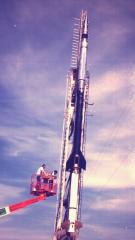 |
|
+ Home | ||

|
||||
| + Solar Cycle Prediction | + Magnetograph | + The Sun in Time | + The Hinode Mission | + The STEREO Mission |
The Multi-Spectral Solar Telescope Array
|
The Multi-Spectral Solar Telescope Array, MSSTA (128 kb GIF image), is a telescope array consisting of at least fifteen different telescopes designed to observe the Sun in ultraviolet and soft x-rays. The project is part of a joint effort between Richard Hoover at MSFC and Art B. C. Walker at Stanford University. Each telescope in the array consists of mirrored optics coated with multilayers to allow for reflection at a selected wavelength. Pre-filters are used to exclude unwanted emissions so that each telescope obtains images at its prescribed wavelength. MSSTA's first flight was on May 13th, 1991 at 19:03 UT. The payload was launched from White Sands Missile Range atop a Terrier Black Brant IX (283 kb GIF image). The telescopes were carried to an altitude of 230 km and remained out of the lower atmosphere for approximately 6 minutes. During this time photographs were taken of the Sun and its outer atmospheric layers, the chromosphere and corona. | ||
|
Images obtained with MSSTA span the wavelength range from Lyman-Alpha emission at 1216 Å to a Si XII emission line at 44 Å. Among these images are:
Ground-based images taken at nearly the same time were acquired from the Big Bear Solar Observatory (BBSO) and the National Solar Observatory (NSO). These images include:
Analysis of these images is in progress. These analyses will help to determine temperatures and densities in the observed coronal structures and provide information on magnetic connections between them. A reflight of the MSSTA payload with several new instruments took place on November 3rd, 1994. | |||
